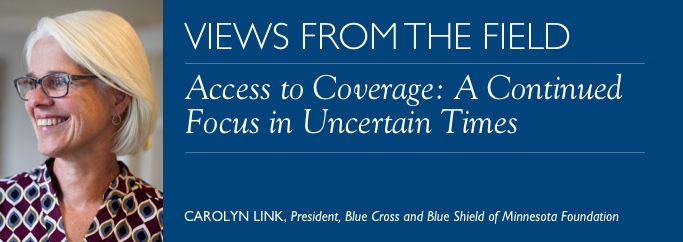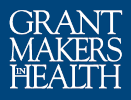
A few short years ago, Minnesota celebrated an all-time low rate of uninsurance. Through the collective effort of navigators, nonprofits, state agencies, health care institutions, and funders across the state, the rate plummeted from 8.2 percent in 2013 to 4.3 percent in 2015. More than 200,000 Minnesotans (including 35,000 children) gained coverage. All groups of Minnesotans, regardless of income, racial/ethnic group, or age, reported increases in coverage. While disparities remained, uninsured rates for Hispanic and Latino Minnesotans fell dramatically.
It is the connection between health and wealth that brought the Blue Cross and Blue Shield of Minnesota Foundation to the issue. Insurance coverage is linked to better and timelier care, and people with coverage are more likely to have a regular place of care. Also, importantly, people with insurance coverage can more easily avoid the medical bankruptcy that plagues uninsured and underinsured people.
The foundation focused on access to coverage in the late 1990s and early 2000s, but we had evolved our support further upstream on social and economic drivers of health. Reframing access to coverage as a strategy that improves both health and financial stability brought the foundation back to a focus on coverage and enabled us to contribute to Minnesota’s success.
Renewing Our Efforts
The foundation used a multifaceted approach to addressing access to coverage. We provided four years of grant funding to key navigator organizations — which help individuals through the application process for state public health care programs — and their partners in each region of the state. We also supported these grantees with training and technical assistance. Navigator organizations built or expanded partnerships to identify potentially eligible people and help them apply for coverage. We also collaborated with MNsure, the state agency that serves as Minnesota’s health exchange and provides access to private and public health coverage programs, to share information and support the navigators’ work. An external evaluator collected detailed data and reported progress quarterly to grantees and the foundation.
Our grantees meaningfully engaged with more than 85,000 individuals and helped more than 40,000 to successfully enroll in MinnesotaCare and Medical Assistance. Most were people of color, women, 34 years of age or younger, born in the United States, and with very low incomes—60 percent of those served had no income or an income at or below the federal poverty level. Grantees assisted Minnesotans in all 87 counties of our state.
After four years and more than $4 million in grants, we considered redirecting funding to other issues. However, after our board’s deliberation, we decided to maintain our focus on access to coverage—reflecting our concern for those who remain uninsured and the possibility that the gains could erode. To help solidify the progress that had been made, we funded a coalition of navigators advocating for the financial, technological, and training sustainability of the statewide navigator network. This was our first grant explicitly centered on advocacy—a significant and carefully considered move by the foundation. We also provided operating grants to two of the original navigator organizations that had deep community connections and demonstrated expertise in reaching and enrolling great numbers of uninsured people.
In addition, the foundation is supporting two research projects. In the first study (completed in the spring), an independent evaluator interviewed leaders from the original grantee network to assess the status of plans for continued navigator services one year after statewide funding from the foundation ended. The results are encouraging: all the original lead organizations continue to provide enrollment services, assess insurance status as part of intake organization-wide, offer post-enrollment support, and track enrollment, and all successfully secured other grant support. The majority have integrated enrollment into staff training and into their strategic plans and have dedicated internal funding to maintaining it as a focus. More than half of the formal partnerships launched during the grants program persist, and new partnerships have been developed. Finally, grantee organizations continue to be seen by their clients and partners as the go-to organizations in their regions for information, services, and enrollment. Persistent challenges include insufficient reimbursement for enrollment services, unpredictable grant support, and technology hurdles.
The second study is modeled after the Blue Cross Blue Shield of Massachusetts Foundation’s 2016 study “Community Matters: Exploring the Link Between Community Characteristics and Uninsurance in Massachusetts.” A Minnesota replication of the study will help navigators and policymakers better understand and provide support to the remaining—and growing—ranks of the uninsured.
Minnesota Today
A report released in February 2018 by Minnesota’s State Health Access Data Assistance Center (SHADAC) showed a big jump in the number of people without health insurance, with some 116,000 more uninsured Minnesotans compared to two years earlier. The uninsured rate rose from 4.3 percent in 2015 to 6.3 percent, leaving about 349,000 Minnesotans without coverage.
Minnesotans are still better off than we were in 2011, when 9.1 percent were uninsured. Importantly, some groups—children, American Indians, and people with incomes at or below the poverty level—maintained their coverage gains from 2015. Yet with nearly 350,000 people without coverage, we are moving further away from our public health goal of achieving universal access to health care.
We have learned that maintaining and increasing access to coverage requires continued focus. Informed by the results of the new research and evaluation projects, as well as the continued work of navigators and advocates, the foundation will consider the best strategies to keep advancing access to coverage under our next strategic plan.
